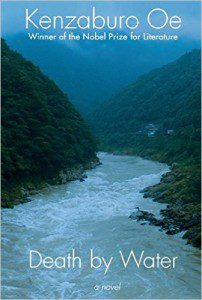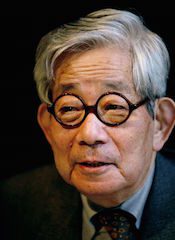
In Kenzaburo Oe’s latest novel, Death by Water, the elderly novelist Kogito Choko renews an old ambition to write his magnum opus regarding the premature death of his father by drowning. His father was allegedly involved in a conspiracy to overthrow the Japanese emperor. Fearing defamation and the publicizing of his father’s ultranationalist leanings, Choko’s mother and sister have guarded a red trunk thought to contain certain documents that disclose the truth of his father’s death. In retaliation, Choko published a highly exaggerated account of the night of the drowning, in which he described a credulous son and his delusional father. His novel scandalized the remaining family and estranged him from them. A decade after his mother’s death, while a theater troupe plans to perform a retrospective of his work, Choko’s sister agrees to release the documents, compelling the author to return to his native forest village.
Oe retells these events using multiple voices, which deepens the sense of incomprehensibility about the unusual circumstances. The characters often use local mythology to confront past events. A pupil of Choko’s father claims that the drowning was a suicide and that a foreign spirit possessed Choko’s father after he adopted an extremist ideology. Choko’s departure into the forest is attributed to the local belief that the forest is a womb and a child always returns to his origin. These conflicting interpretations are given equal authority, further mystifying things. The novel gives a sense that no amount of documentation could add up to an authoritative account: Choko’s magnum opus was always an impossibility. Between these myths and its more pedestrian concerns about novelistic ambition and family strife, Death by Water constructs a densely textured myth of the night in question.
The novel concerns itself with the overwhelming duty of sacrificing an individual self in respect to community. The theater troupe performs an open-forum interpretation of the classic Japanese play Kokoro, in which a teacher leaves his sole pupil autobiographical notes prior to his suicide. Oe cleverly questions whether this teacher’s suicide was an act of mourning for the end of the Meji era, or an atonement for a betrayal decades earlier. This contrapuntal narrative recalls Choko’s mother’s description of a past when her village’s ancestors lived in the forest: “We think now that our individuality is terribly important, but back in the time when we were in the marvelous forest, even though we were individual entities, we were all part of a greater whole.” In the novel’s treatment, the most popular interpretation of Kokoro offers the suicide as an individual act, one ultimately concerned “with the question of the human heart—of the individual, by the individual, for the individual.” Oe probes these delicate affairs with evenhandedness but his allegiances are made manifest: confronted with the mystery of death—and for Oe, death is unresolvable—one cannot condense a man into a mere symbol.

For Choko, writing the novel results in the discovery of his father’s preparations for death. The novelist finds that his father’s marginalia has been preserved on the pages of The Golden Bough, an anthropological study of folklore meant as instructions for deposing an impotent leader. It seems poignant to the novelist that although his father “was obediently going along with the plan… it appears as though he was trying to read it from a more artistic perspective as well. This has been a revelation for me, for the first since I was born, I feel as if I’m seeing my father for who he really was.” For Choko, his father’s documents are a miraculous revelation. The letters of the dead are treated as tenderly as the bodies themselves. There is a reverence ascribed to the written word: these stories, when transcribed, whatever their provenance, are already on the cusp of joining the local repository of myths.
Death by Water is a novel whose elegant architecture depends on the variation of a theme, or the revision of the account of the night in question. What is constant in this lyrical meditation on remembrance is a relentless desire to find meaning in death.




